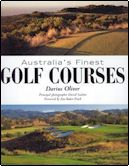THE METROPOLITAN GOLF CLUB - EXCLUSIVE REVIEW
by Darius Oliver, from Australia's Finest Golf Courses
.jpg)
The Metropolitan Golf Club
Course Opened – 1908
Designer – J.B. Mackenzie, Dr Alister MacKenzie, Dick Wilson
right - The finishing hole at Metropolitan (image by Gary Lisbon)
The second oldest golf club in the Sandbelt, Metropolitan’s founding members were originally part of Royal Melbourne when the club golfed on a leased estate near the Caulfield railway station. Fearing for the future of their links, the majority of members moved to a permanent home at Sandringham while those for whom the Caulfield course was more accessible remained. A few years later these ‘stay at home’ members purchased the Barholme Estate in Oakleigh and relocated as The Metropolitan Golf Club.

The chosen site was farmland with less natural undulation than Royal Melbourne but the same fertile sandy base found throughout Melbourne’s Sandbelt region. Initially lacking feature, decades of maturation and shrewd club management saw the flat countryside famously transformed into a site of regal and botanical beauty boasting an impeccable golf course of international significance.
Image left - courtesy Gary Lisbon
Engineer member J.B. Mackenzie laid out the first course, with his routing taking advantage of the unusual shape of the estate by including several fine doglegs and fairways that ran in a number of directions. The design was complimented by magnificent plantings of Australian native trees and shrubs, which remain Metropolitan’s most distinguishable feature. His most celebrated hole was the old par four 14th, described by Gene Sarazen in 1936 as ‘one of golf’s best.’
With seven of the first nine holes continuing to play along the lines he laid out, J.B. Mackenzie is considered the clubs spiritual father. The final two holes are also close to his originals although the 17th was shifted slightly east when the course was rearranged during the 1960’s, which brought the now famous row of Swamp Cypresses into play for the first time.
The other MacKenzie, Dr Alister, also had a major hand in the design of Metropolitan, advising on possible course improvements during his 1926 visit to Melbourne. His principal observations were that the bunkering lacked strategy and had not been positioned close enough to the greens. He also suggested some minor routing changes. MacKenzie’s influence on the current course should not be understated, as aside from designing the brilliant bunkering and altering some of the greens, he also moved the first tee to create an outstanding dogleg, and shifted the current 9th green back to its present location.
Sadly with the exception of the final two holes and the tee shot on the 10th, none of the other back nine holes are arranged as either Mackenzie had intended. American Dick Wilson rebuilt these holes in 1960 when the rapid expansion of the surrounding residential community forced the club to sell their beloved southern holes for a local school development. Fortunately the club managed to purchase a tongue of market garden that extended into its original site and Wilson was able to skilfully design seven new holes to blend into the established course. The only distinguishable differences are minor aesthetic contrasts between the bunkering. Though classics like the old 14th could not duplicated, he did build a superb long par four at the 15th while the 16th, with its myriad of sand, has become one of the highlights.
Following this period of upheaval came a resolve within the club to re-establish the course as one of the nation’s best with the focus shifting towards improving the playing surfaces. Their success has been extraordinary, especially since the early 1990’s, with Metropolitan now revered both locally and internationally as having some of the finest golfing turf on the planet.

Aside from immaculate grooming the tree-lined fairways also provide a constant feeling of seclusion and isolation on virtually every hole. As far back as 1926 the beauty of the site was undeniable, even moving the well travelled Dr MacKenzie to comment that ‘no remarks upon the Metropolitan Club would be complete without reference to the magnificent plantations. From a field, plain, unattractive and lacking beauty in the first place, it has been transformed into its present state of sylvan glory. Metropolitan members certainly take their golf in beautiful surroundings.’
above - Image by Gary Lisbon
Decades of additional growth and the sensible fine tuning of the exceptional three-man design has furthered this experience and surpassed what either pioneering Mackenzie could have reasonably imagined during the clubs formative years. The modern Metropolitan membership is truly one of the most spoilt in Australia.
 This review features in Australia's Finest Golf Courses (RRP $49.95).
This review features in Australia's Finest Golf Courses (RRP $49.95).
For more details on the book click here.
Green Fee access - Access to this private club is restricted to members, guests of members and Golf Club Members from Interstate and Overseas upon payment of the applicable green fee. ausgolf can advise about playing this course, or provide additional travel advice, so please e-mail travel@ausgolf.com.au

